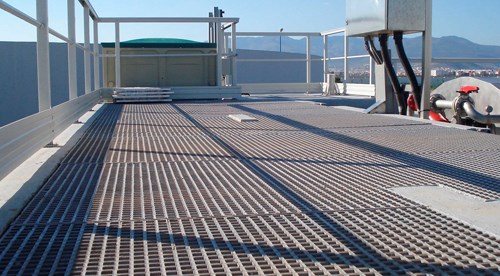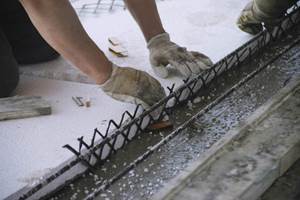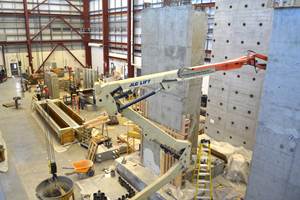ACMA publishes manual for FRP grating
ACMA issues standard for fiberglass grating with an eye for expanding the industrial composites market

The American Composites Manufacturers Association (ACMA, Arlington, VA, US) has published a new manual under the banner of the American National Standards Institute (ANSI, Washington, DC, US). “FRP Composites Grating Manual for Pultruded and Molded Grating and Stair Treads” is intended to educate engineers, designers and end-users about the properties, performance and uses of fiber-reinforced polymer (FRP) grating. Greater knowledge of the performance benefits of FRP will increase awareness of the material and enable engineers to design and use FRP with confidence, says ACMA. FRP grating is used in many industries, from walkways in industrial plants to flooring on ships to decorative grids on commercial and residential buildings. It is more durable and corrosion resistant than steel, which can rust and corrode in extreme environments.
Aldred D’Souza, P.E., the director of engineering/design at Fibergrate Composite Structures Inc. (Dallas, TX, US) and the chair of ACMA’s Fiberglass Grating Manufacturers Council, says, “The successful completion of the FRP Composites Grating Manual marks a major milestone in the advancement of the Industry. This new standard should increase the awareness of FRP grating and its suitability in a wide range of markets beyond wastewater treatment plants, waterparks and chemical plants. As FRP gratings become more mainstream because of this wider acceptance, market expansion for composites is evident.” Other members of the Fiberglass Grating Manufacturers Council who also participated in development of the publication include Strongwell (Bristol, VA, US), Delta Composites LLC (Spring, TX, US), Seasafe Inc. (Lafayette, LA, US), Creative Pultrusions Inc. (Alum Bank, PA, US), Owens Corning (Toledo, OH, US), Interplastic Corp. (St. Paul, MN, US), Precisioneering Ltd. (Scarborough, Ontario, Canada), and ChinaGrate (Nantong, Jiangsu Province, China).
The new publication is not a design manual nor requirement, but a voluntary consensus standard. Approval of an American National Standard requires review by ANSI and assurance that the requirements for due process, consensus and other criteria for approval have been met by the standards developer, in this case, ACMA. Consensus is established when, in the judgment of the ANSI Board of Standards Review, substantial agreement has been reached by “directly and materially affected interests.” The use of American National Standards is completely voluntary; their existence does not in any respect preclude anyone, whether he or she has approved the standard or not, from manufacturing, marketing, purchasing, or using products, processes, or procedures not conforming to the standards, emphasizes ACMA in the standard’s Preface.
The FRP Composites Grating Manual has three sections:
- Load Tables: A quick reference for engineers to compare the performance of FRP grating types under specified load conditions.
- Code of Standard Practice: Representation of generally accepted standard practices in the fiberglass grating industry
- Generic Specification: Suggested guidance for engineers and owners when purchasing composite grating, keeping all grating manufacturers on a level playing field. This specification also promotes manufacturing of gratings that will have minimum performance standards.
The new FRP Composites Grating Manual (print and digital versions) can be found at the ACMA Education Hub. The manual costs $50 for ACMA members and $75 for nonmembers for a hard copy. A digital download (PDF) version costs $40 for members and $60 for nonmembers.
To learn more about ACMA’s Fiberglass Grating Manufacturers Council, contact John Busel at jbusel@acmanet.org.
Related Content
CirculinQ: Glass fiber, recycled plastic turn paving into climate solutions
Durable, modular paving system from recycled composite filters, collects, infiltrates stormwater to reduce flooding and recharge local aquifers.
Read MoreComposites-reinforced concrete for sustainable data center construction
Metromont’s C-GRID-reinforced insulated precast concrete’s high strength, durability, light weight and ease of installation improve data center performance, construction time and sustainability.
Read MoreKU researchers explore FRP materials for dams, levee reinforcement
To address aging infrastructure, a team of researchers at KU is conducting research into repairing and retrofitting 700-plus dams, levees and related structures nationwide using FRP materials.
Read MoreSwedish parking garage to incorporate decommissioned wind blades
Architect Jonas Lloyd is working with Vattenfall to design the multistory building with a wind blade façade, targeting eco-friendly buildings and creative ways to remove blades from landfills.
Read MoreRead Next
“Structured air” TPS safeguards composite structures
Powered by an 85% air/15% pure polyimide aerogel, Blueshift’s novel material system protects structures during transient thermal events from -200°C to beyond 2400°C for rockets, battery boxes and more.
Read MoreAll-recycled, needle-punched nonwoven CFRP slashes carbon footprint of Formula 2 seat
Dallara and Tenowo collaborate to produce a race-ready Formula 2 seat using recycled carbon fiber, reducing CO2 emissions by 97.5% compared to virgin materials.
Read MoreVIDEO: High-volume processing for fiberglass components
Cannon Ergos, a company specializing in high-ton presses and equipment for composites fabrication and plastics processing, displayed automotive and industrial components at CAMX 2024.
Read More






















